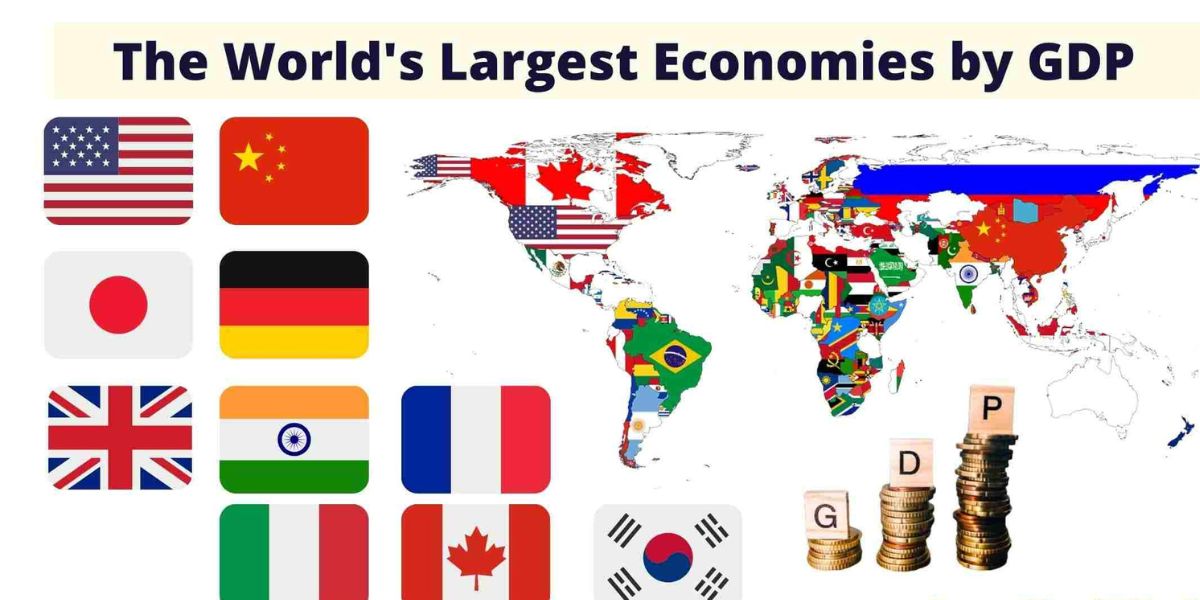The steady race for economic growth and power shapes the world’s economy. In this article, we will take a complete look at the real GDP of the top 10 largest economies in the world. These economies significantly impact the global economy and significantly contribute to growth and wealth worldwide.
An In-Depth Analysis of the Top 10 Economies of the World:
1. United States: A Technologically Advanced Economic Giant
The United States remains at the top of the list of the ten largest economies in the world, with a real GDP of $25.03 trillion. The U.S. economy does well because it has a robust services sector. Services make up about 80% of the country’s total output. The scientific skills and market power of big companies in areas like technology, shopping, finance, and healthcare significantly affect the global economy.
2. China: Unprecedented Growth and Economic Ascendancy
China is second on the list of the top 10 largest economies in the world, with a real GDP of $18.32 trillion, thanks to its incredible economic growth over the past few decades. The country’s economic growth is due to its focus on building facilities, making things for sale, and developing new technologies. China has a lot of people, and the number of people in the middle class is growing. This makes local spending strong, which helps China’s economy grow.
3. Japan: Overcoming Challenges and Sustained Growth
With an estimated real GDP of $4.3 trillion, Japan is in third place on our list of the top 10 largest economies in the world. Japan’s economy increased from the 1960s to the 1980s, but the 1990s were hard for the country. But Japan has taken reasonable steps in recent years to get its economy going again. Focusing on new technologies, improved industry, and research and development is vital to the country’s continued progress.
4. Germany: Engineering Excellence and Economic Resilience
Germany has a real GDP of $4 trillion, which puts it in fourth place among the largest economies in the world. Even though Germany’s economy had a short pause in 2009, it has been growing steadily since then. The country’s strengths are its sound engineers, high-quality industry, and the fact that it sells cars, machines, and chemicals. Germany’s economy is vital because it invests in research and development, has a skilled workforce, and has a robust infrastructure.
5. India: Rapid Growth and Emerging Powerhouse
India’s economy is one of the most active in the world. With a real GDP of $3.4 trillion, it is the fifth-largest economy in the world. The country’s economy is more significant than France’s and is rising faster than any other large global economy. India has a young and skilled workforce, a growing middle class, and skills in information technology services, medicines, and telecommunications. India’s economy is growing because the government is putting more effort into industry and digital change.
6. United Kingdom: Navigating Uncertainty and Economic Challenges
The United Kingdom, with a real GDP of $3.1 trillion, holds the sixth position among the top 10 economies in the world. From 1999 to 2008, the UK’s GDP grew by an average of 2.8% per year, but uncertainty about Brexit has hurt the country’s economy. The drop in private spending and the slowing of fixed assets are both problems. But the UK’s economy will continue to be strong because of its vital services sector, which includes banking, the creative industry, and research.
7. France: Service Sector Dominance and Industry Leadership
France is the seventh-largest economy in the world based on its real GDP, estimated to be $2.7 trillion. Over 70% of the country’s GDP comes from the service sector, and France is also a leader in the automobile, train, and military sectors. The country’s strong economy is due to its highly skilled workers, drive for research and development, and strategic leadership in key industries.
8. Canada: Stability and Resource Abundance
Canada has the world’s ninth-largest economy, with a GDP of $2.2 trillion. The country’s economy is doing well because it is stable, has a lot of natural resources, and has a diverse service industry. Canada is a significant producer of energy, minerals, and forest goods, and its vital services sector includes banks, healthcare, and technology. Canada’s economy is doing well because its workers are well-trained, and the country is committed to new ideas.
9. Russia: A Key Player in the Global Economy
With a real GDP of $2.1 trillion, Russia is a significant player in the global economic landscape. As the world’s 11th largest economy, Russia possesses vast natural resources, including oil, gas, and minerals, contributing to its financial strength. The country’s industries, such as energy, aerospace, and arms manufacturing, are crucial in driving economic growth. Additionally, Russia’s strategic geographical location and engagement in international trade further enhance its economic significance.
10. Italy: Market Development and Innovative Business Sectors
Italy has a very well-developed market as the country with the third-largest economy in the European Union. Italy has a real GDP of $1.99 trillion, which makes it the eighth-largest economy in the world. People know the country for its powerful and creative business sectors, harsh agriculture industry, and well-known brands. Italy’s economy continues to grow because of its dedication to research and development and its skilled workers.
| Sl. No. | Country Name | Continent | Nominal GDP Count (USD) |
|---|---|---|---|
| 1 | United States | America | 25,035,164 |
| 2 | China | Asia | 18,321,197 |
| 3 | Japan | Asia | 4,300,621 |
| 4 | Germany | Europe | 4,031,149 |
| 5 | India | Asia | 3,468,566 |
| 6 | United Kingdom | Europe | 3,198,470 |
| 7 | France | Europe | 2,778,090 |
| 8 | Canada | America | 2,200,352 |
| 9 | Russia | Europe | 2,133,092 |
| 10 | Italy | Europe | 1,996,934. |
Conclusion
The top 10 largest economies in the world are the United States, China, Japan, Germany, the United Kingdom, India, France, Italy, Canada, and South Korea. They are all having a significant influence on the global economy. These nations have several advantages, including technical advancement, a thriving economy, a robust service sector, and abundant natural resources. As these nations cope with difficulties and capitalise on their unique characteristics, they affect the global economy and generate development and riches.




